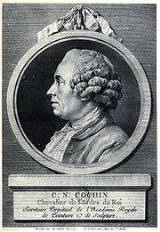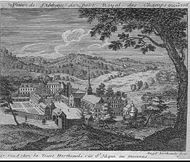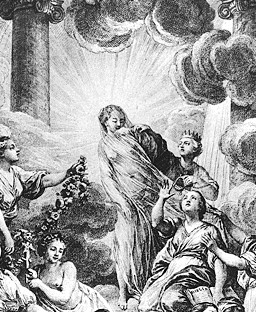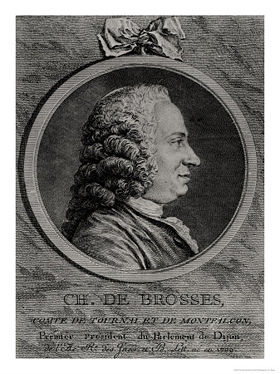
Charles-Nicolas Cochin
Encyclopedia
Charles-Nicolas Cochin was a French engraver, designer
, writer, and art critic
. To distinguish him from his father of the same name, he is variously called Charles-Nicolas Cochin le Jeune (the Younger), Charles-Nicolas Cochin le fils (the son), or Charles-Nicolas Cochin II.
 Cochin was born in Paris
Cochin was born in Paris
, the son of Charles-Nicolas Cochin the Elder
(1688–1754), under whom he studied engraving. His mother was Louise-Magdeleine Horthemels (1686–1767), who herself was an important engraver in Paris for some fifty years.
Beyond his artistic education, Cochin taught himself Latin, English, and Italian
, and he read the work of the philosopher John Locke
in the original.
As well as having natural talent and academic training, Cochin benefited from good connections in the world of art. As well as both of his parents being engravers, his mother's two sisters, Marie-Nicole Horthemels (b. 1689, died after 1745) and Marie-Anne-Hyacinthe Horthemels (1682–1727), worked in the same field. Marie-Nicole was married to the portrait artist Alexis Simon Belle
, while Marie-Anne-Hyacinthe was the wife of Nicolas-Henri Tardieu. Tardieu (1674–1749) was another eminent French engraver, a member of the Academy from 1720, who engraved the works of masters of the Renaissance
and of his own time.
The Horthemels family, originally from The Netherlands, were followers of the Dutch theologian Cornelis Jansen and had links with the Parisian abbey of Port-Royal des Champs, the centre of Jansenist thought in France.
In the 1730s, Cochin was a member of the Gobelins group which centred around Charles Parrocel
.
 Cochin rose quickly to success and fame. As early as 1737, he was employed by the young King Louis XV
Cochin rose quickly to success and fame. As early as 1737, he was employed by the young King Louis XV
to make engravings to commemorate every birth, marriage, and funeral at the king's court
, and from 1739 he was formally attached as designer and engraver to the Menus-Plaisirs du Roi
, where all such ephemeral occasions were produced.
As well as being an engraver to the court, he was also a designer, a writer on art, and a portrait artist
.
In 1749 Mme de Pompadour selected Cochin to accompany her brother Abel Poisson, the future marquis de Marigny
, on a study tour of Italy, in the company of the architect Jacques-Germain Soufflot
and the art-critic Jean-Bernard, abbé Le Blanc
. Cochin, Soufflot and Marigny remained close friends on their return, when their considerable combined influence did much to bring about the triumph of Neoclassicism
in France.
On his return in 1751 he was admitted a member of the Royal Academy of Painting and Sculpture
, where he had been agréé since 1741. In 1752, following the death of Charles-Antoine Coypel
, he was appointed as Coypel's successor as keeper of the king's drawings and given a lodging in the Louvre
. From 1755 to 1770, he had the title of the King's administrator of the arts, and in this role he commissioned work from other artists, established programmes for the decoration of the king's palace
s and chateau
x, and granted pensions. Between 1750 and 1773, Cochin's work was directed by the Marquis de Marigny, King Louis XV's director of the Bâtiments du Roi
. Cochin was effectively Marigny's academic liaison.
In 1750-1751, Cochin, with Jérôme-Charles Bellicard, accompanied Marigny on a visit to the excavations at Herculaneum
. In 1753, Cochin and Bellicard published their Observations upon the Antiquities of the Town of Herculaneum, the first illustrated account of the discoveries there, which largely caused the frescoes of Herculaneum to be disregarded. Editions of the work in English were published in 1753, 1756, and 1758, and in French
in 1754, 1755 and 1757.
Cochin was able to influence the artistic taste of France and was one of his country's primary leaders of taste during the eighteenth century. His years of greatest administrative influence were from 1752 to 1770.
In 1755, he became Secretary (secrétaire historiographe) of the Academy, a position he still held in 1771, and for one year he was director of the Société académique des Enfants d'Apollon.
He was a frequent guest at the dinners given by Madame Geoffrin
, and was said to speak brilliantly at them of painting and engraving.
Cochin saw himself as an educator and was critical of the Rococo
style, whose extravagance he publicly criticised in letters in the Mercure de France
He argued for technical precision and for skill in the use of natural elements. In the 1750s he also attacked the early, extreme phase of Neo-classicism known as the Goût grec
, exemplified in the work of the architect Jean-François de Neufforge.
King Louis XV rewarded Cochin's talents with a patent of nobility and membership of the Order of Saint Michael
and granted him a pension. However, after the death of Louis XV in 1774, Cochin fell out of royal favour, and in his later years he lived in comparative poverty.
 More than fifteen hundred works by Cochin can be identified. They include historical subjects, book illustrations, and portraits in pencil and crayon. The richest collection of his engravings, apparently selected by himself, is in the Royal Library, now part of the Bibliothèque National.
More than fifteen hundred works by Cochin can be identified. They include historical subjects, book illustrations, and portraits in pencil and crayon. The richest collection of his engravings, apparently selected by himself, is in the Royal Library, now part of the Bibliothèque National.
Cochin's own compositions are usually rich, gracious, and speak of a man full of erudition.
A notable piece of work is his frontispiece
to the 1764 edition of Diderot
's Encyclopédie
, entitled Lycurgue blessé dans une sédition. Of his historical work, the best known prints include The death of Hippolytus, after François de Troy
, and David playing the harp before Saul. As well as his many drawings, he illustrated more than two hundred books and also designed paintings and sculptures.
With Philippe Lebas, an early master of Cochin's, he engraved sixteen plates in the series Ports of France, of which fifteen are after paintings by Vernet and one designed by himself.
More than three hundred of his portraits are listed by Christian Michel in his monumental Charles-Nicolas Cochin et l'art des Lumières (1993).
Cochin's published and unpublished texts, including over six hundred surviving letters, and the lectures he gave at meetings of the Academy, are listed by Michel. If his style sometimes lacks elegance, it is always clear and precise.
s called 'Cochin' were designed by Georges Peignot and named after Charles-Nicolas Cochin the Younger, first appearing in 1912 and 1914. However, neither is clearly derived from Cochin’s own work.

Designer
A designer is a person who designs. More formally, a designer is an agent that "specifies the structural properties of a design object". In practice, anyone who creates tangible or intangible objects, such as consumer products, processes, laws, games and graphics, is referred to as a...
, writer, and art critic
Art critic
An art critic is a person who specializes in evaluating art. Their written critiques, or reviews, are published in newspapers, magazines, books and on web sites...
. To distinguish him from his father of the same name, he is variously called Charles-Nicolas Cochin le Jeune (the Younger), Charles-Nicolas Cochin le fils (the son), or Charles-Nicolas Cochin II.
Early life

Paris
Paris is the capital and largest city in France, situated on the river Seine, in northern France, at the heart of the Île-de-France region...
, the son of Charles-Nicolas Cochin the Elder
Charles-Nicolas Cochin the Elder
Charles Nicolas Cochin the Elder, a French line-engraver, was born in Paris in 1688. His father, Charles Cochin, was a painter, and Charles Nicolas followed the same profession until he was twenty-two years of age, when he abandoned painting and devoted himself entirely to engraving...
(1688–1754), under whom he studied engraving. His mother was Louise-Magdeleine Horthemels (1686–1767), who herself was an important engraver in Paris for some fifty years.
Beyond his artistic education, Cochin taught himself Latin, English, and Italian
Italian language
Italian is a Romance language spoken mainly in Europe: Italy, Switzerland, San Marino, Vatican City, by minorities in Malta, Monaco, Croatia, Slovenia, France, Libya, Eritrea, and Somalia, and by immigrant communities in the Americas and Australia...
, and he read the work of the philosopher John Locke
John Locke
John Locke FRS , widely known as the Father of Liberalism, was an English philosopher and physician regarded as one of the most influential of Enlightenment thinkers. Considered one of the first of the British empiricists, following the tradition of Francis Bacon, he is equally important to social...
in the original.
As well as having natural talent and academic training, Cochin benefited from good connections in the world of art. As well as both of his parents being engravers, his mother's two sisters, Marie-Nicole Horthemels (b. 1689, died after 1745) and Marie-Anne-Hyacinthe Horthemels (1682–1727), worked in the same field. Marie-Nicole was married to the portrait artist Alexis Simon Belle
Alexis Simon Belle
Alexis Simon Belle was a French portrait painter, known for his portraits of the French and Jacobite nobility.-Birth:...
, while Marie-Anne-Hyacinthe was the wife of Nicolas-Henri Tardieu. Tardieu (1674–1749) was another eminent French engraver, a member of the Academy from 1720, who engraved the works of masters of the Renaissance
Renaissance
The Renaissance was a cultural movement that spanned roughly the 14th to the 17th century, beginning in Italy in the Late Middle Ages and later spreading to the rest of Europe. The term is also used more loosely to refer to the historical era, but since the changes of the Renaissance were not...
and of his own time.
The Horthemels family, originally from The Netherlands, were followers of the Dutch theologian Cornelis Jansen and had links with the Parisian abbey of Port-Royal des Champs, the centre of Jansenist thought in France.
In the 1730s, Cochin was a member of the Gobelins group which centred around Charles Parrocel
Charles Parrocel
Charles Parrocel was a French painter and engraver and a specialist in battle and hunt paintings.Parrocel was born in Paris, and studied under his father, Joseph Parrocel, until his death. Parrocel then became a pupil along with Bon Boullogne of Charles de La Fosse...
.
Career

Louis XV of France
Louis XV was a Bourbon monarch who ruled as King of France and of Navarre from 1 September 1715 until his death. He succeeded his great-grandfather at the age of five, his first cousin Philippe II, Duke of Orléans, served as Regent of the kingdom until Louis's majority in 1723...
to make engravings to commemorate every birth, marriage, and funeral at the king's court
Noble court
The court of a monarch, or at some periods an important nobleman, is a term for the extended household and all those who regularly attended on the ruler or central figure...
, and from 1739 he was formally attached as designer and engraver to the Menus-Plaisirs du Roi
Menus-Plaisirs du Roi
The Menus-Plaisirs du Roi was, in the organisation of the French royal household under the Ancien Régime, the department of the Maison du Roi responsible for the "lesser pleasures of the King", which meant in practice that it was in charge of all the preparations for ceremonies, events and...
, where all such ephemeral occasions were produced.
As well as being an engraver to the court, he was also a designer, a writer on art, and a portrait artist
Portrait
thumb|250px|right|Portrait of [[Thomas Jefferson]] by [[Rembrandt Peale]], 1805. [[New-York Historical Society]].A portrait is a painting, photograph, sculpture, or other artistic representation of a person, in which the face and its expression is predominant. The intent is to display the likeness,...
.
In 1749 Mme de Pompadour selected Cochin to accompany her brother Abel Poisson, the future marquis de Marigny
Abel-François Poisson, marquis de Marigny
Abel-François Poisson de Vandières, marquis de Marigny and marquis de Menars , often referred to simply as marquis de Marigny, was a French nobleman who served as the director general of the King's Buildings...
, on a study tour of Italy, in the company of the architect Jacques-Germain Soufflot
Jacques-Germain Soufflot
Jacques Germain Soufflot was a French architect in the international circle that introduced Neoclassicism. His most famous work is the Panthéon, Paris, built from 1755 onwards, originally as a church dedicated to Sainte Genevieve.- Biography :Soufflot was born in Irancy, near Auxerre.In the 1730s...
and the art-critic Jean-Bernard, abbé Le Blanc
Jean-Bernard, abbé Le Blanc
Jean-Bernard, abbé Le Blanc was a French art critic, one of the Parisian literati, who through his patron Mme de Pompadour was appointed historiographer of the Bâtiments du Roi, the defender of state expenditures and official French policy in the arts, and was also an advocate before the Parlement...
. Cochin, Soufflot and Marigny remained close friends on their return, when their considerable combined influence did much to bring about the triumph of Neoclassicism
Neoclassicism
Neoclassicism is the name given to Western movements in the decorative and visual arts, literature, theatre, music, and architecture that draw inspiration from the "classical" art and culture of Ancient Greece or Ancient Rome...
in France.
On his return in 1751 he was admitted a member of the Royal Academy of Painting and Sculpture
Académie de peinture et de sculpture
The Académie royale de peinture et de sculpture , Paris, was founded in 1648, modelled on Italian examples, such as the Accademia di San Luca in Rome. Paris already had the Académie de Saint-Luc, which was a city artist guild like any other Guild of Saint Luke...
, where he had been agréé since 1741. In 1752, following the death of Charles-Antoine Coypel
Charles-Antoine Coypel
Charles-Antoine Coypel was a French painter, art commentator, and playwright. He lived in Paris. He was the son of the artist Antoine Coypel and grandson of Noël Coypel. Charles-Antoine inherited his father’s design and painting duties as premier peintre du roi at the French court when his father...
, he was appointed as Coypel's successor as keeper of the king's drawings and given a lodging in the Louvre
Louvre
The Musée du Louvre – in English, the Louvre Museum or simply the Louvre – is one of the world's largest museums, the most visited art museum in the world and a historic monument. A central landmark of Paris, it is located on the Right Bank of the Seine in the 1st arrondissement...
. From 1755 to 1770, he had the title of the King's administrator of the arts, and in this role he commissioned work from other artists, established programmes for the decoration of the king's palace
Palace
A palace is a grand residence, especially a royal residence or the home of a head of state or some other high-ranking dignitary, such as a bishop or archbishop. The word itself is derived from the Latin name Palātium, for Palatine Hill, one of the seven hills in Rome. In many parts of Europe, the...
s and chateau
Château
A château is a manor house or residence of the lord of the manor or a country house of nobility or gentry, with or without fortifications, originally—and still most frequently—in French-speaking regions...
x, and granted pensions. Between 1750 and 1773, Cochin's work was directed by the Marquis de Marigny, King Louis XV's director of the Bâtiments du Roi
Bâtiments du Roi
The Bâtiments du Roi was a division of Department of the household of the Kings of France in France under the Ancien Régime. It was responsible for building works at the King's residences in and around Paris.-History:...
. Cochin was effectively Marigny's academic liaison.
In 1750-1751, Cochin, with Jérôme-Charles Bellicard, accompanied Marigny on a visit to the excavations at Herculaneum
Herculaneum
Herculaneum was an ancient Roman town destroyed by volcanic pyroclastic flows in AD 79, located in the territory of the current commune of Ercolano, in the Italian region of Campania in the shadow of Mt...
. In 1753, Cochin and Bellicard published their Observations upon the Antiquities of the Town of Herculaneum, the first illustrated account of the discoveries there, which largely caused the frescoes of Herculaneum to be disregarded. Editions of the work in English were published in 1753, 1756, and 1758, and in French
French language
French is a Romance language spoken as a first language in France, the Romandy region in Switzerland, Wallonia and Brussels in Belgium, Monaco, the regions of Quebec and Acadia in Canada, and by various communities elsewhere. Second-language speakers of French are distributed throughout many parts...
in 1754, 1755 and 1757.
Cochin was able to influence the artistic taste of France and was one of his country's primary leaders of taste during the eighteenth century. His years of greatest administrative influence were from 1752 to 1770.
In 1755, he became Secretary (secrétaire historiographe) of the Academy, a position he still held in 1771, and for one year he was director of the Société académique des Enfants d'Apollon.
He was a frequent guest at the dinners given by Madame Geoffrin
Marie Thérèse Rodet Geoffrin
Marie Thérèse Rodet Geoffrin has been referred to as one of the leading female figures in the French Enlightenment. From 1750-1777, Madame Geoffrin played host to many of the most influential Philosophes and Encyclopédistes of her time...
, and was said to speak brilliantly at them of painting and engraving.
Cochin saw himself as an educator and was critical of the Rococo
Rococo
Rococo , also referred to as "Late Baroque", is an 18th-century style which developed as Baroque artists gave up their symmetry and became increasingly ornate, florid, and playful...
style, whose extravagance he publicly criticised in letters in the Mercure de France
Mercure de France
The Mercure de France was originally a French gazette and literary magazine first published in the 17th century, but after several incarnations has evolved as a publisher, and is now part of the Éditions Gallimard publishing group....
He argued for technical precision and for skill in the use of natural elements. In the 1750s he also attacked the early, extreme phase of Neo-classicism known as the Goût grec
Goût grec
Goût grec is the term applied to the earliest expression of the neoclassical style in France, it refers specifically to the decorative arts and architecture of the mid-1750s to the late 1760s. The style was more fanciful than historically accurate though the first archaeological surveys of Greece...
, exemplified in the work of the architect Jean-François de Neufforge.
King Louis XV rewarded Cochin's talents with a patent of nobility and membership of the Order of Saint Michael
Order of Saint Michael
The Order of Saint Michael was a French chivalric order, founded by Louis XI of France in 1469, in competitive response to the Burgundian Order of the Golden Fleece founded by Philip the Good, duke of Burgundy, Louis' chief competitor for the allegiance of the great houses of France, the Dukes of...
and granted him a pension. However, after the death of Louis XV in 1774, Cochin fell out of royal favour, and in his later years he lived in comparative poverty.
Works of art

Cochin's own compositions are usually rich, gracious, and speak of a man full of erudition.
A notable piece of work is his frontispiece
Book frontispiece
A frontispiece is a decorative illustration facing a book's title page. The frontispiece is the verso opposite the recto title page. Elaborate engraved frontispieces were in frequent use, especially in Bibles and in scholarly books, and many are masterpieces of engraving...
to the 1764 edition of Diderot
Denis Diderot
Denis Diderot was a French philosopher, art critic, and writer. He was a prominent person during the Enlightenment and is best known for serving as co-founder and chief editor of and contributor to the Encyclopédie....
's Encyclopédie
Encyclopédie
Encyclopédie, ou dictionnaire raisonné des sciences, des arts et des métiers was a general encyclopedia published in France between 1751 and 1772, with later supplements, revised editions, and translations. It was edited by Denis Diderot and Jean le Rond d'Alembert...
, entitled Lycurgue blessé dans une sédition. Of his historical work, the best known prints include The death of Hippolytus, after François de Troy
François de Troy
François de Troy was a French painter and engraver who became principal painter to King James II in exile at Saint-Germain-en-Laye and Director of the Académie Royale de peinture et de sculpture.-Early life:...
, and David playing the harp before Saul. As well as his many drawings, he illustrated more than two hundred books and also designed paintings and sculptures.
With Philippe Lebas, an early master of Cochin's, he engraved sixteen plates in the series Ports of France, of which fifteen are after paintings by Vernet and one designed by himself.
More than three hundred of his portraits are listed by Christian Michel in his monumental Charles-Nicolas Cochin et l'art des Lumières (1993).
Major publications
- Cochin, Charles-Nicolas, Voyage d'Italie, ou recueil de notes sur les ouvrages de peinture et de sculpture qu'on voit dans les principales villes d'Italie (Paris, 1751, in 3 volumes)
- Cochin, Charles-Nicolas (with Bellicard, Jérôme-Charles), Observations upon the Antiquities of the Town of Herculaneum (London 1753, English edition, Paris 1754, French edition)
- Cochin, Charles-Nicolas, Recueil de quelques pièces concernant les arts, avec une dissertation sur l'effet de la lumière et des ombres relativement à la peinture (Paris, 1757, in 3 volumes)
- Cochin, Charles-Nicolas, Réflexions sur la critique des ouvrages exposés au Louvre (Paris, 1757)
- Cochin, Charles-Nicolas, Les Misotechnistes aux enfers, ou Examen critique des observations de N.D.L.G sur les arts (Amsterdam and Paris, 1763)
- Cochin, Charles-Nicolas (with Patte, Pierre, and Chaumont, chevalier de), Projet d'une salle de spectacle pour un théâtre de comédie (London and Paris, 1765, new edition Geneva, Minkoff, 1974)
- Cochin, Charles-Nicolas, Lettres sur les vies de M. Slodtz et de M. Deshays (Paris, 1765)
- Cochin, Charles-Nicolas, Lettre à une société d'amateurs prétendus (1769)
- Under the pseudonym of Jérôme, Réponse à M. Raphaël (Paris, 1769)
- Cochin, Charles-Nicolas, Les Amours rivaux, ou l'homme du monde (Paris, 1774)
- Cochin, Charles-Nicolas, Lettres sur l'Opéra (Paris, 1781)
- Cochin, Charles-Nicolas, Lettres à un jeune artiste peintre (undated)
Cochin's published and unpublished texts, including over six hundred surviving letters, and the lectures he gave at meetings of the Academy, are listed by Michel. If his style sometimes lacks elegance, it is always clear and precise.
Fonts named Cochin
In the early twentieth century, two fontFont
In typography, a font is traditionally defined as a quantity of sorts composing a complete character set of a single size and style of a particular typeface...
s called 'Cochin' were designed by Georges Peignot and named after Charles-Nicolas Cochin the Younger, first appearing in 1912 and 1914. However, neither is clearly derived from Cochin’s own work.

External links
- Charles Nicolas Cochin the Younger (French, 1715-1790) at artnet.com

